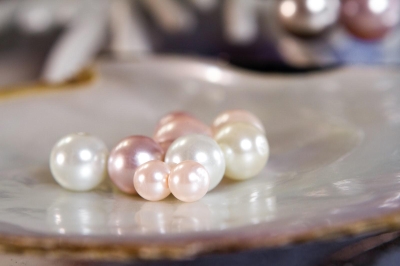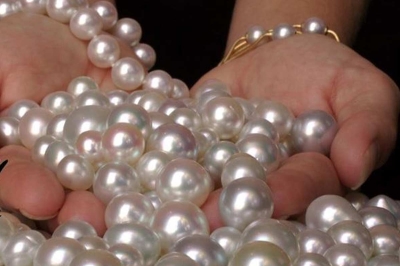Buying And Selling Pearls In The Middle East
Pearl stone is a gem from ancient times and about 6 thousand years ago, which was used as an ornament by kings and nobles. Sometimes pearls, sometimes fish and shrimp, and sometimes oil have added to the economic importance of the Persian Gulf. The most valuable pearls in the world belong to the Persian Gulf, and these pearls are caught in a completely natural and traditional way by local divers. Natural pearls are formed naturally inside mollusks, such as oysters or mussels, without any human intervention. Pearl farmers employ various techniques to culture pearls, resulting in different types. The value of a pearl can vary dramatically depending on factors such as type, size, color, surface quality, and more.
What is a natural pearl?

A natural pearl is a gemstone formed inside the soft tissue of a living mollusk, such as an oyster or a mussel. It is produced when an irritant, such as a grain of sand or a parasite, enters the mollusk's shell and becomes trapped within the mantle tissue. In response to this irritant, the mollusk secretes layers of nacre, a mixture of calcium carbonate and organic substances, around the foreign object. Over time, these layers build up, forming a pearl. The formation of a natural pearl is a rare occurrence and takes several years to develop. The resulting pearl has a unique shape, luster, and color, influenced by various factors such as the species of mollusk, the environment it lives in, and the specific conditions of the pearl formation.
In salt water, pearls are found in oysters, while in fresh water they are produced by oysters. When a foreign substance, such as a food particle, slips into a mollusk, the creature protects itself by covering the irritant with layers of crustaceans. Cord is also a material that gives shine to jewelry. Due to their rarity and the natural process of their formation, natural pearls are highly valued in the jewelry industry. However, the majority of pearls available today are cultivated or cultured pearls, which are created through a process where humans introduce an irritant into the mollusk to initiate pearl formation. These cultured pearls closely resemble natural pearls in appearance but are less expensive and more readily available.
What is a natural pearl?, Read More ...
Add your import and export orders to this list
Warning: Undefined variable $formTitle in /home/anbar/domains/anbar.asia/anbar/inc/html/desktop/orderform.php on line 10
Warning: Undefined variable $marketName in /home/anbar/domains/anbar.asia/anbar/inc/html/desktop/orderform.php on line 12
Warning: Undefined variable $location in /home/anbar/domains/anbar.asia/anbar/inc/html/desktop/orderform.php on line 12
If you want to trade in the , please join in Anbar Asia. Your order will be shown here, so the traders of contact you

Natural pearl fishing in the Persian Gulf

Natural pearl fishing in the Persian Gulf has a rich history that dates back centuries. The Persian Gulf, particularly the waters surrounding present-day Bahrain, was renowned for its abundant oyster beds and high-quality natural pearls. The region was once one of the world's primary sources of natural pearls. Traditional pearl fishing in the Persian Gulf involved skilled divers who would plunge into the depths of the sea to collect oysters from the ocean floor. These divers often used techniques such as free diving or using weighted baskets to reach the oyster beds. The divers faced significant risks, including drowning, shark attacks, and the bends (decompression sickness) due to diving without modern equipment.
Today, natural pearl fishing in the Persian Gulf is a rare and limited practice. It is primarily conducted for cultural or historical purposes rather than commercial gain. The focus has shifted to the preservation of the traditional techniques and the promotion of the region's rich pearling heritage. Museums, exhibitions, and educational initiatives showcase the significance of natural pearls in the Persian Gulf's history and culture. The quality of pearls in Iran and the Persian Gulf is largely influenced by its special nature. In rare cases, you can see salty and sweet waters and springs next to each other. The nature of the sea has a great influence on the formation and activity rhythm of organisms. The pearl of the Persian Gulf is also formed in the inner shell of molluscs, and if we humans abuse the sea ecosystem or pollute it, this process will face a problem.
Natural pearl fishing in the Persian Gulf, Read More ...
The best natural pearls in the world

The waters of the Persian Gulf, particularly around Bahrain, were historically famous for producing some of the finest natural pearls. These pearls were highly valued for their luster, roundness, and unique colors. The South Sea, particularly around Australia, Indonesia, and the Philippines, is known for producing large and lustrous natural pearls. South Sea pearls are often prized for their size, ranging from 10 to 20 millimeters, and their creamy white or golden hues. The Gulf of Mannar, located between India and Sri Lanka, has been historically recognized for producing high-quality natural pearls. These pearls are appreciated for their rich luster, roundness, and soft, warm hues.
The waters around French Polynesia, specifically Tahiti, are renowned for producing Tahitian pearls. These pearls are celebrated for their dark and exotic colors, including black, gray, peacock green, and blue. Tahitian pearls are often characterized by their size, unique overtones, and desirable surface markings. The Sea of Cortez, located between Baja California and mainland Mexico, is known for producing rare and exceptional natural pearls. The pearls from this region are highly regarded for their rich colors, including vibrant pinks, purples, and golds.
The best natural pearls in the world, Read More ...
The difference between natural pearls and artificial and cultured pearls

Natural pearls are formed naturally inside mollusks, such as oysters or mussels, without any human intervention. They occur when an irritant, like a grain of sand or a parasite, enters the mollusk's shell, leading to the secretion of nacre (mother-of-pearl) layers around the irritant over time. Natural pearls are rare and highly valued due to their organic formation and unique characteristics. Cultured pearls are created through a process called pearl culturing, which involves human intervention. In pearl farming, a technician carefully implants a nucleus, often a small round bead, into the mollusk's mantle tissue. The mollusk then reacts to this irritant by secreting nacre layers around it, resulting in the formation of a pearl. Cultured pearls closely resemble natural pearls in appearance and are available in various shapes, sizes, and colors. They are more affordable and readily available compared to natural pearls.
Artificial pearls, also known as imitation or faux pearls, are not produced by living organisms. They are man-made and typically made of glass, plastic, or other materials. Artificial pearls are manufactured by coating a nucleus or a bead with a material that mimics the appearance of natural pearls. They lack the depth, luster, and organic structure of natural or cultured pearls. Cultured or cultured pearls are created in an interesting way. The pearl cultivator places a small amount of sand between the shell and the soft shell of the fish. After 2 or 3 years, the cultured pearl can be extracted by breaking the shell. The only difference between cultured pearls and natural pearls is that these pearls do not have a perfect appearance. But the country of Japan has been able to create cultured pearls that are completely similar to natural pearls by placing sand particles right in the shell.
The difference between natural pearls and artificial and cultured pearls, Read More ...
Types of pearls

Pearl farmers employ various techniques to culture pearls, resulting in different types. Different methods of nucleation, implantation, and farming conditions can influence the shape, size, and quality of the resulting pearls. For instance, freshwater pearls are cultivated in freshwater environments, while saltwater pearls are produced in marine environments. Different species of mollusks produce pearls with distinct characteristics. For example, Akoya pearls are primarily produced by the Pinctada fucata oyster, while South Sea pearls come from the Pinctada maxima oyster. Each species has its unique traits, such as size, luster, and color, resulting in a variety of pearl types.
The environment in which the mollusks live or are cultured impacts the growth and appearance of pearls. Factors such as water quality, temperature, salinity, and nutrient availability can affect the formation process, resulting in characteristic differences among pearl types. For example, Tahitian pearls develop their distinctive dark colors due to the unique conditions in the waters around Tahiti. Genetic factors can also contribute to variations in pearls. Just as individual humans have unique traits, mollusks within the same species can exhibit genetic variation, resulting in differences in pearl characteristics.
Types of pearls, Read More ...
How is the price of pearls determined?

The type of pearl plays a significant role in determining its price. Certain types, such as natural pearls or rare varieties like conch pearls or natural-color Tahitian pearls, command higher prices due to their scarcity and uniqueness. The size of a pearl impacts its value. Generally, larger pearls are rarer and more valuable compared to smaller ones. The size is measured in millimeters, and significant jumps in size can result in exponential increases in price.
The surface quality of a pearl is assessed by examining its smoothness, absence of blemishes, and presence of imperfections. Pearls with fewer surface flaws and blemishes command higher prices, while those with visible imperfections are less valuable. The color of a pearl influences its price. While white and cream-colored pearls are classic and widely popular, pearls with unique and rare colors, such as black Tahitian pearls or pink conch pearls, can be more valuable. The intensity, evenness, and rarity of the color impact the price. Nacre, the substance that forms the pearl's layers, affects its durability, luster, and overall quality. Pearls with thick, well-formed nacre layers are considered superior and thus more valuable.
How is the price of pearls determined?, Read More ...




